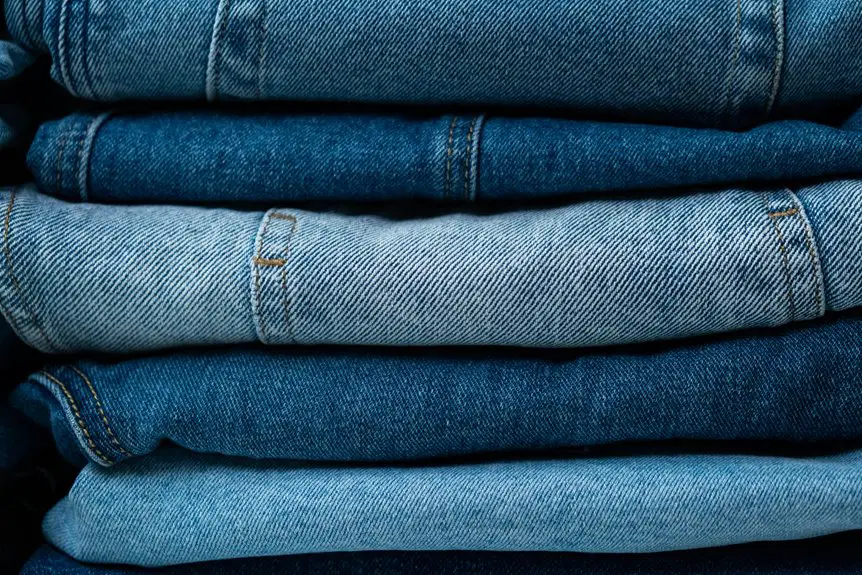Fabric dye bleeding happens when the dye isn’t properly fixed to the fibers, causing it to leach out during washing. Natural fibers, like cotton, are more porous and consequently bleed more than synthetics. Hot water and harsh detergents can worsen the issue, while washing in cold water helps prevent it. Color-catchers can reduce dye transfer between items. Understanding these factors is key to preserving your clothes—keep exploring to discover effective prevention techniques and remedies.
Table of Contents
Key Takeaways
- Dye bleeding occurs when improperly fixed dye is released from fabric, often influenced by water temperature and agitation during washing.
- Natural fibers like cotton are more prone to bleeding than synthetic fibers due to their higher porosity and dye absorption capacity.
- Heat and harsh detergents increase dye leaching by breaking chemical bonds between the dye and fabric fibers, facilitating molecular diffusion.
- Preventive measures, such as washing in cold water and using color-catching sheets, can significantly reduce the risk of dye transfer.
- Vinegar can serve as a color fixative, helping to stabilize dyes and minimize bleeding during laundry.
Understanding Fabric Dye Bleeding
When you wash colored fabrics, you might notice that some dyes bleed into the water, leaving your clothes looking less vibrant. This phenomenon, known as dye bleeding, occurs when the dye used in the fabric isn’t fixed properly.
It can happen due to various factors, including the type of dye, fabric composition, and washing conditions. Natural fibers like cotton often bleed more than synthetic fibers because of their porous nature.
Additionally, washing in hot water or using harsh detergents can exacerbate the issue. To minimize dye bleeding, always wash colored items in cold water, and consider using a color-catching sheet.
Mechanisms of Dye Leaching
Dye leaching occurs through specific mechanisms that cause the color to escape from the fabric during washing. One primary mechanism is molecular diffusion, where dye molecules move from the fabric into the water due to concentration gradients. As the water absorbs heat, it increases the movement of these molecules, facilitating their exit.
Another mechanism involves the interaction between water and the dye’s chemical bonds. If the dye isn’t tightly bound to the fabric fibers, water can break these bonds, leading to leaching.
Additionally, mechanical agitation during washing can dislodge dye particles, further promoting their release. Understanding these mechanisms helps you appreciate why certain fabrics bleed more than others during laundering, guiding your choices for care and maintenance.
Factors That Contribute to Color Bleeding
Color bleeding can occur for several reasons, and understanding them can help you prevent it.
One major factor is the type of dye used; some dyes are more prone to bleeding than others. Additionally, the fabric’s fiber content plays an essential role—natural fibers like cotton tend to absorb dyes more readily, increasing the risk.
Temperature is another key player; hot water can cause dyes to release more easily. If you wash clothes with varying colors together, the darker fabrics can leach onto lighter ones.
Finally, improper curing of the dye during manufacturing can lead to unstable colors. By recognizing these factors, you can better anticipate and manage potential color bleeding in your garments.
Effective Prevention Techniques
To prevent fabric dye bleeding, you can use simple techniques like applying vinegar during the wash.
This natural solution helps set the dye and reduces color transfer.
Additionally, using color catchers in your laundry can trap loose dyes, keeping your clothes vibrant and safe from unwanted stains.
Vinegar Application Benefits
Using vinegar in your fabric care routine can greatly reduce the risk of dye bleeding. This natural solution helps set the dye, ensuring your clothes stay vibrant and true to color.
Here are a few benefits of using vinegar:
- Color Fixative: It helps lock in dyes, preventing them from running during washes.
- Odor Neutralizer: Vinegar eliminates unpleasant smells, leaving your fabrics fresh.
- Fabric Softener: It softens your clothes without harsh chemicals, making them more comfortable to wear.
- Stain Remover: Vinegar can break down tough stains, keeping your garments looking their best.
Incorporating vinegar into your laundry routine not only protects your fabrics but also enhances their overall quality.
Give it a try!
Color Catcher Usage
In addition to vinegar, incorporating color catchers into your laundry routine can greatly enhance your fabric protection strategy.
These innovative sheets work by trapping loose dyes in the wash, preventing them from settling on your clothes. To use them effectively, simply toss a color catcher sheet into your washing machine along with your mixed loads. They’re particularly helpful when you’re washing new or brightly colored fabrics that might bleed.
Make sure to follow the package instructions for ideal results. You’ll notice fewer color transfer issues, and your clothes will maintain their vibrancy.
Consequences of Dye Bleeding on Fabrics
While you mightn’t realize it at first, dye bleeding can considerably impact your fabrics, leading to unsightly stains and altered colors. This can ruin your favorite clothes and affect their longevity.
The consequences are often more severe than you think, including:
- Stains: Unwanted color transfer can create persistent marks.
- Color Fading: Original hues may dull, diminishing your fabric’s vibrancy.
- Reduced Value: Damaged items lose their worth, both sentimentally and financially.
- Compromised Quality: Repeated bleeding can weaken fabric fibers, affecting durability.
Being aware of these consequences can help you take better care of your garments.
It’s essential to recognize the signs early on to prevent further damage and maintain your fabrics’ integrity.
Solutions and Remedies for Dye Bleeding
To tackle dye bleeding, it’s essential to take preventive measures before washing your fabrics.
You can also treat existing bleeding with effective remedies that help restore your clothes.
Let’s explore both strategies to keep your fabrics looking fresh and vibrant.
Preventive Measures Before Washing
Before you toss your colorful fabrics into the wash, taking a few precautionary steps can save you from the frustration of dye bleeding.
Here are some effective measures you can take:
- Sort your laundry: Separate darks, lights, and whites to minimize color transfer.
- Use cold water: Wash in cold water to help prevent dye from releasing.
- Add a color catcher: These sheets absorb loose dyes during the wash, protecting your fabrics.
- Test for colorfastness: Dab a small, hidden area with water and check if the dye runs before washing.
Treatment for Existing Bleeding
If you’ve already encountered dye bleeding, don’t despair—there are several effective solutions to restore your fabric’s original colors.
First, try soaking the affected fabric in a solution of cold water and a color-safe bleach for about 30 minutes. Rinse thoroughly afterward.
If that doesn’t work, you can use a color remover, following the product instructions carefully.
For less severe cases, a mixture of white vinegar and water can help lift stubborn stains.
After treating the fabric, wash it separately in cold water with a gentle detergent.
Finally, air dry your fabric to avoid any heat-induced damage.
Always test any solution on a small, inconspicuous area first to prevent further issues.
Frequently Asked Questions
Can All Fabrics Bleed Dye, or Just Specific Types?
Not all fabrics bleed dye; it mainly depends on the dye type and the fabric’s composition. Natural fibers like cotton and silk often bleed more than synthetic materials. Always check care labels before washing.
How Can I Test for Colorfastness Before Washing?
About 30% of fabrics can bleed dye when washed. To test for colorfastness, dampen a white cloth and rub it on the fabric. If the color transfers, you know it’s likely to bleed.
Does Fabric Dye Bleeding Affect Only Clothing?
Fabric dye bleeding doesn’t just affect clothing; it can ruin linens, upholstery, and other textiles too. You’ll want to be cautious when mixing items in the wash to prevent unwanted color transfer.
Are There Specific Detergents That Prevent Dye Bleeding?
You might be surprised, but certain detergents do help prevent dye bleeding! Look for options labeled as color-safe or designed for dark fabrics, and your laundry will stay vibrant longer without fading or bleeding.
Is It Possible to Reverse Dye Bleeding Once It Occurs?
Yes, you can sometimes reverse dye bleeding. Try soaking the fabric in a solution of vinegar and water or using color removers specifically designed for fabrics. Always test a small area first to avoid further damage.
- How Exactly Does Friction Cause Fabric Pilling on Clothes? - June 10, 2025
- What Are the Worst Fabrics for Pilling That I Should Try to Avoid? - June 10, 2025
- How to Choose Non-Pilling Fabrics for Children’s Clothing? - June 10, 2025







